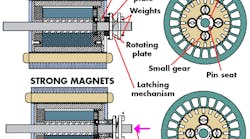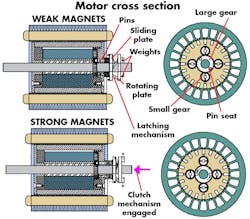The quest for energy efficient electric motors has generated a lot of interesting ideas. One of the latest is said to push the efficiency of induction motors to better than super-premium levels by changing the orientation of rotor magnets on the fly.
A company called Motor Generator Technology in Signal Hill, Calif., says it is using the technique both in so-called hybrid induction motors and in generators that produce a steady output even when spinning at variable speeds. MGT CEO Louis Finkle says he is in talks with the industrial supply house W.W. Granger about supplying a half-horse version of the induction motor design. Finkle thinks generators built using his reconfigurable magnet idea will come in handy for applications like wind turbines where they could generate a constant output from variable wind speeds without the use of intermediate inverters.
Both the induction motor and the generator design vary the strength of rotor magnets depending on rotor speed. Moreover, the adjustment takes place through purely electromechanical means without the use of any electromagnetic coils.
In the case of the induction motor, a centrifugal clutch-like mechanism handles the adjustment. When the rotor reaches a predetermined rotational speed, weights deploy outward and cause an axial spring disc to snap. This action retracts pins from seats and lets rotor magnets rotate 90° into a position where they produce maximum magnetic flux influence on stator windings.
Conversely, magnets sit in a position that exerts a weak magnetic field on stator windings when the motor is stationary. Magnets return to this position as the rotor slows down.
The overall effect of this change in magnet position is that the motor starts up in asynchronous mode as a conventional induction motor. But once the centrifugal latching mechanism actuates and the magnets rotate into position, the motor effectively operates like a synchronous reluctance motor.
Finkle says there are a variety of ways to realize the mechanics for rotating the magnets and controlling PM flux. Another technique he's devised employs a linear motor to move a shaft that, in turn, moves arms coupled to rack-and-pinion mechanisms. The rack-and-pinion mechanisms rotate sliding cylindrical bushings with gear teeth around their outside diameter which, in turn, rotate the rotor magnets.
"Synchronous generators usually have a separately excited stator which goes through a diode bank. This technique eliminates the need for this whole electrical system," says Finkle.
He says the rotating magnet system also has advantages in the case of a catastrophic stator failure. "The generator linkage lets you relax the system so it instantly neutralizes itself. There is no dynamic braking at all," he says.
Interestingly, Finkle says the inertia from the mechanisms associated with rotating magnets don't degrade the motor efficiency. "There is a bit of extra inertia, but the rotor doesn't weigh much more than a standard rotor of a surface or internal PM design," he says. "We are replacing voids within the rotor with active material so the impact is minimal."
Finkle thinks one prime application for MGT's Variable Flux Generator motor is in large electric vehicles such as trucks and buses. "It could literally eliminate the need for all gearing in 18 wheelers which normally have 16 forward gears and 10 gears in reverse," he claims. "You could set the base speed at perhaps 500 rpm and it would give outrageous torque. But the same motor could accelerate with no rise in back EMF voltage to run at 10 to 12 times base speed. And you could continually adjust the back EMF to give optimum voltage to the battery without having to use inverters."
Perhaps more important, Finkle says the MGT hybrid induction motors can potentially be less expensive than super-premium-efficiency motors because they don't resort to use of more copper or high-quality laminations. He also says the company has developed a rotor retrofit process for motors of 200 hp and above that can boost efficiency levels from 96% to about 98%.
Nevertheless, Finkle thinks the first large market for the technology may be in generators rather than in motors. "Large synchronous generators currently use a control system and a small ac generator whose field circuits mount on the stator and armature circuits mount on the rotor shaft. The output is rectified to dc and fed into the main dc field circuit. There is about an 8% loss because of the flux they must generate to stimulate the stator. We can eliminate that loss and reduce the size of the generator as well," Finkle says.


